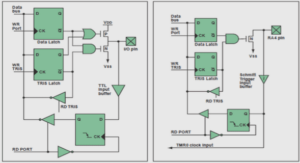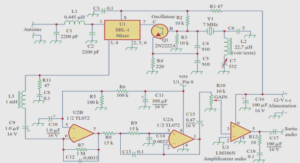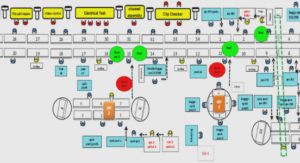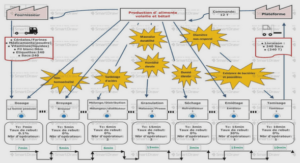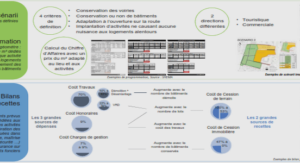Modeling of the failure mechanisms
Micromechanical modeling
An orthogonal parallelepipedic unit cell is chosen since periodic boundary conditions can be easily prescribed without any restriction on the stress state (Fig. 7-1a). In addition to periodic boundary conditions, the unit cell is subject to proportional loading in the macroscopic stress space. In other words, the ratios of the principal values of the macroscopic stress tensor are kept constant up to the onset of localization. For an isotropic unit cell, these ratios can be directly linked to the macroscopic stress triaxiality and the Lode angle parameter. Consequently, the plastic work up to shear localization can then be easily computed as a function of the stress state. However, one immediate consequence of this choice of a parallelepipedic unit cell is the loss of isotropy. The results will be generated for an infinite medium with spherical defects that are located at the vertices of an orthorhombic lattice in the initial configuration, leading to a topological orthotropy of the model. Moreover, the shape of the spherical defects changes throughout loading, introducing another deviation from the assumption of isotropy (morphological anisotropy). As will be explained in detail below, two measures are taken to minimize the effect of spurious anisotropy on our simulation results: firstly, a very low defect volume fraction corresponding to that observed experimentally is chosen; secondly, the orientation of the applied macroscopic principal stresses are constantly updated such that they coincide with the major axes of the ellipsoidal approximation of the shape of the deforming defect.
3D unit cell model geometry and boundary conditions
The undeformed unit cell consists of a rectangular cuboid of matrix material containing a spherical void at its center. We introduce the fixed Cartesian frame [ ] corresponding to the normals to the cell’s outer surfaces in the initial (undeformed) configuration. We limit our attention to a unit cell with the initial edge lengths and (Fig. 7-1a); the height-to-width ratio of is chosen to facilitate the detection of localization using a purely kinematic criterion. The cell features a central spherical void of radius which corresponds to an initial porosity of . Defining the macroscopic deformation gradient as the spatial average of the local deformation gradient over the unit cell volume, the boundary conditions are chosen such that a gradient of the form (7-1) can be applied to the unit cell. In other words, the unit cell is subject to normal loading along all its boundaries and shear loading in the – -plane. Denoting the average normal displacement along a boundary of normal as , and the average tangential displacements along the direction on the boundaries of normal the surfaces of normal as , the macroscopic deformation gradient reads [ ] (7-2) 148 Chapter 7. Modeling of the failure mechanisms For the isotopic matrix material, the associated mechanical problem is symmetric with respect to the ( ) plane, and antisymmetric with respect to the ( ) plane. Thus, only one quarter of the cell ( , and ) is considered (Fig. 7-1b) for finite element analysis. The geometry is discretized with eight-node solid elements with an edge length increasing from to .
Macroscopic rate of deformation tensor
According to the above boundary conditions, the four displacement degrees of freedom, [ ] { } (7-7) control the average deformation gradient in the unit cell. Introducing the current velocity vector ̇[ ], the macroscopic rate of deformation tensor can be calculated, ( ̇ ) ̇ ̇ ̇ ( ) ( ̇ ̇ ) ( ) (7-8) The corresponding velocity gradient features only four non-zero components which are summarized in a rate of deformation vector { } (7-9) And expressed as a linear function of the current macroscopic velocities, [ ] ̇ (7-10) with the time-dependent linear transformation [ ] [ ] (7-11) 150 Chapter 7. Modeling of the failure mechanisms 7.2.3 Control of the macroscopic stress state The macroscopic stress tensor [ ] is defined as the spatial average of the current local Cauchy stress field [ ], ∫ [ ] (7-12) with [ ] denoting the current macroscopic volume of the unit cell. is fully characterized by its principal stresses and principal stress directions , and . In this study we focus on biaxial tension under plane stress condition only (7-13) However, without actually explicitly calculating the macroscopic stress tensor, the stress ratio ⁄ will be kept constant and the plane stress condition maintained throughout the simulations through a time-dependent kinematic constraint on the applied macroscopic velocities ̇. Consider first the rate of mechanical work for the unit cell at time t. It may be written as ̇ ̇ (7-14) In (7-14), denotes the vector of the work conjugate forces to the macroscopic translational degrees of freedom, while the vector is work conjugate to . It summarizes four of the six independent components of the symmetric macroscopic Cauchy stress tensor, { } (7-15) It is assumed that the shear components and (which may become non-zero due to the deformation induced anisotropy at the mesoscale) remain always small as compared to the other stress components and are thus neglected thereafter. In addition the normal to the plane of possible localization is expected to be orthogonal to the second principal stress direction (Rudnicki and Rice, 1975, [153]).

